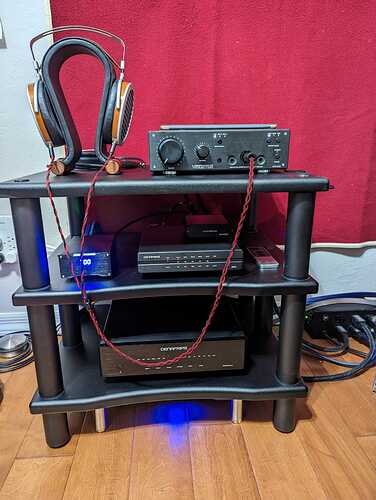After a few days with the opticalRendu I have a lot of thoughts. First off, thanks again @Polygonhell for the hot tip on the killer used price! I can’t believe I got this unit for 1/3 retail price!
It will probably take a few posts to get all my thoughts organized and written down.
First off, the simplicity of this device can’t be overstated. Small, light weight, clean case aesthetic. It’s such a straight forward little device it helped cleanup my overall equipment rack. (Please ignore fingerprints on the amp… needs a cleanup really badly.)
Running optical to the streamer helped with my cable routing OCD, knowing the fiber cable position didn’t matter.
I’m using a SGC linear power supply at 7V, with a DH Labs Mirage USB cable into an Iris DDC (then i2s into Pontus2).
Streaming is from Roon Core connected to Mikrotik 5 port SFP switch running on a 12V SGC linear power supply. Multi-mode SFP transceiver modules (both in switch and opticalRendu are made by Finisar. Roon Core is in an Akasa fanless case. The RPi4 in the picture is for running HQPlayer (more on that later).
The ease of use, and snappy playback time make streaming with the oR very enjoyable. It’s performance in this regard is comparable to a RPi4 endpoint. Nice to use, very fast.
The sonic performance (coming from a RPi4 running Ropieee with SGC LPS) is a very clear step up. It reminds me of adding a DDC to the system, it’s like having an all new DAC. The spacial presentation is vastly improved - black black background, wide sound stage, improved layering, a noticable upgrade to “holographicity”. It’s pulling performance out of the DAC/Amp/headphone that I didn’t know was there. Fit example, the HekV2 is a wide and well layered headphone, and with the oR added to my signal chain, it’s wider, more layered, and more naturally tambered. And the dynamics weren’t reduced at all. Just as much punch/slam as before, but with the rest of the spacial presentation improved.
Today I started experimenting with HQPlayer via the oR. Very very easy to use and setup. I need more time with it before reporting any sonic opinions. But from a usability perspective, I couldn’t be happier. In fact, switching between sources (Roon, HQPlayer, DLNA, Spotify, AirPlay, …) is fast and easy.
One very interesting observation, the sonic impact of changing USB cable between oR and Iris DDC was shockingly obvious. My thought going in was that such a setup would diminish the impact of the USB cable. But it actually made it more pronounced. I tried generic USB, Curious USB, Silver Dragon, and DH Labs Mirage. All 4 sounded different, and in my system I found the Mirage to give a touch of warmth and smoothness over the rest that I really enjoyed.
After my time with it, I do actually think it’s worth the $1.8k new price. It’s bringing a lot of value. But that’s a hard price to pay for such a small piece. If you can get one used (and you want to experiment with optical networking), it’s 100% worth it.




